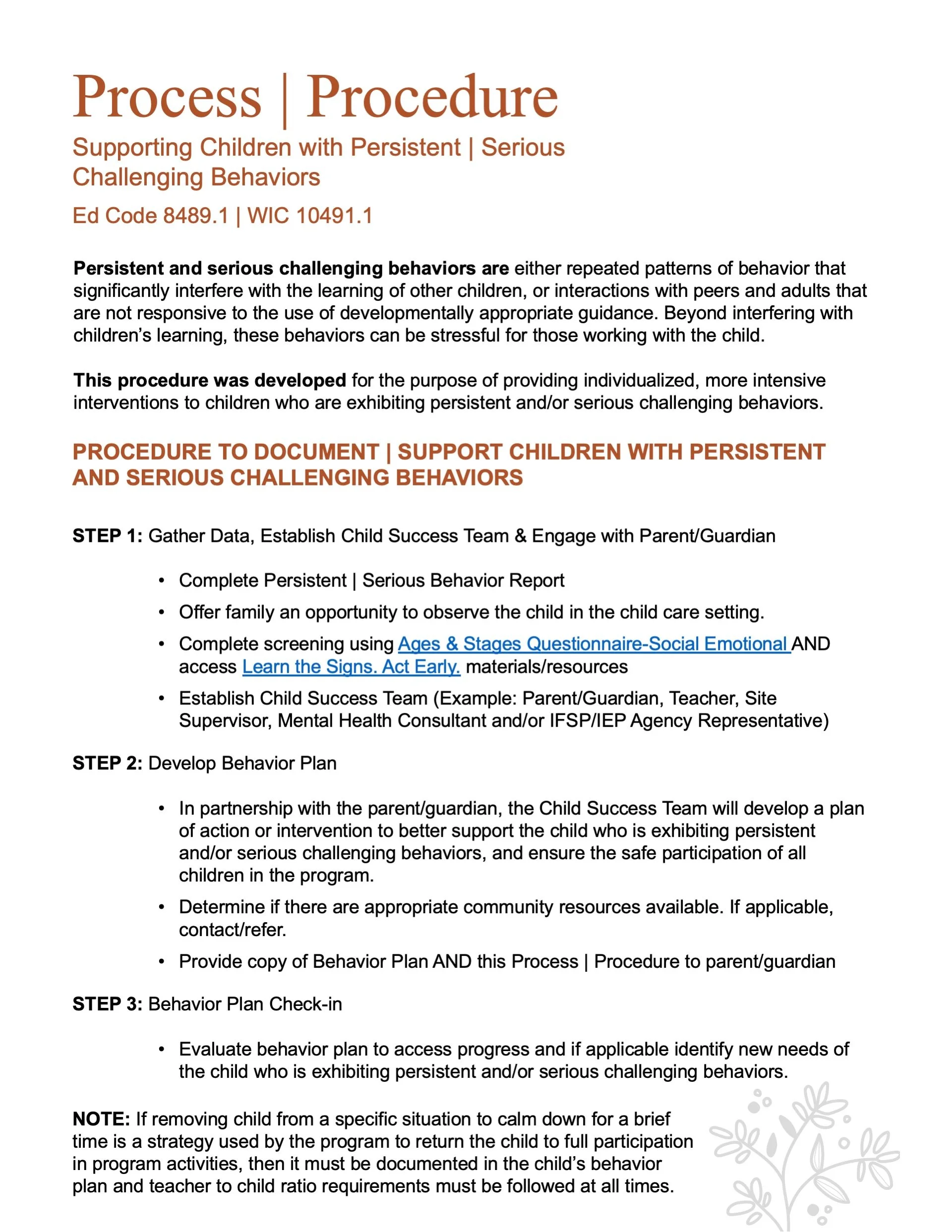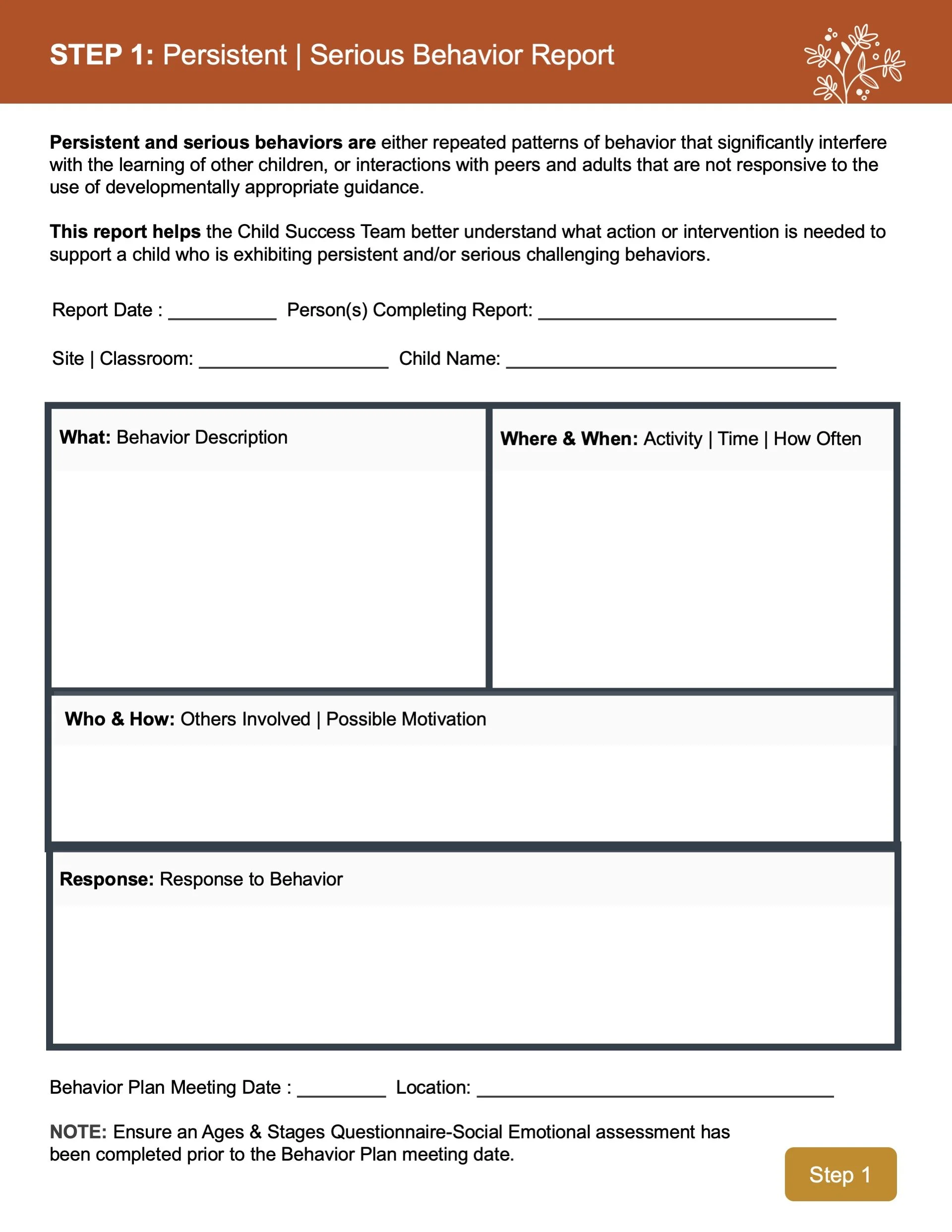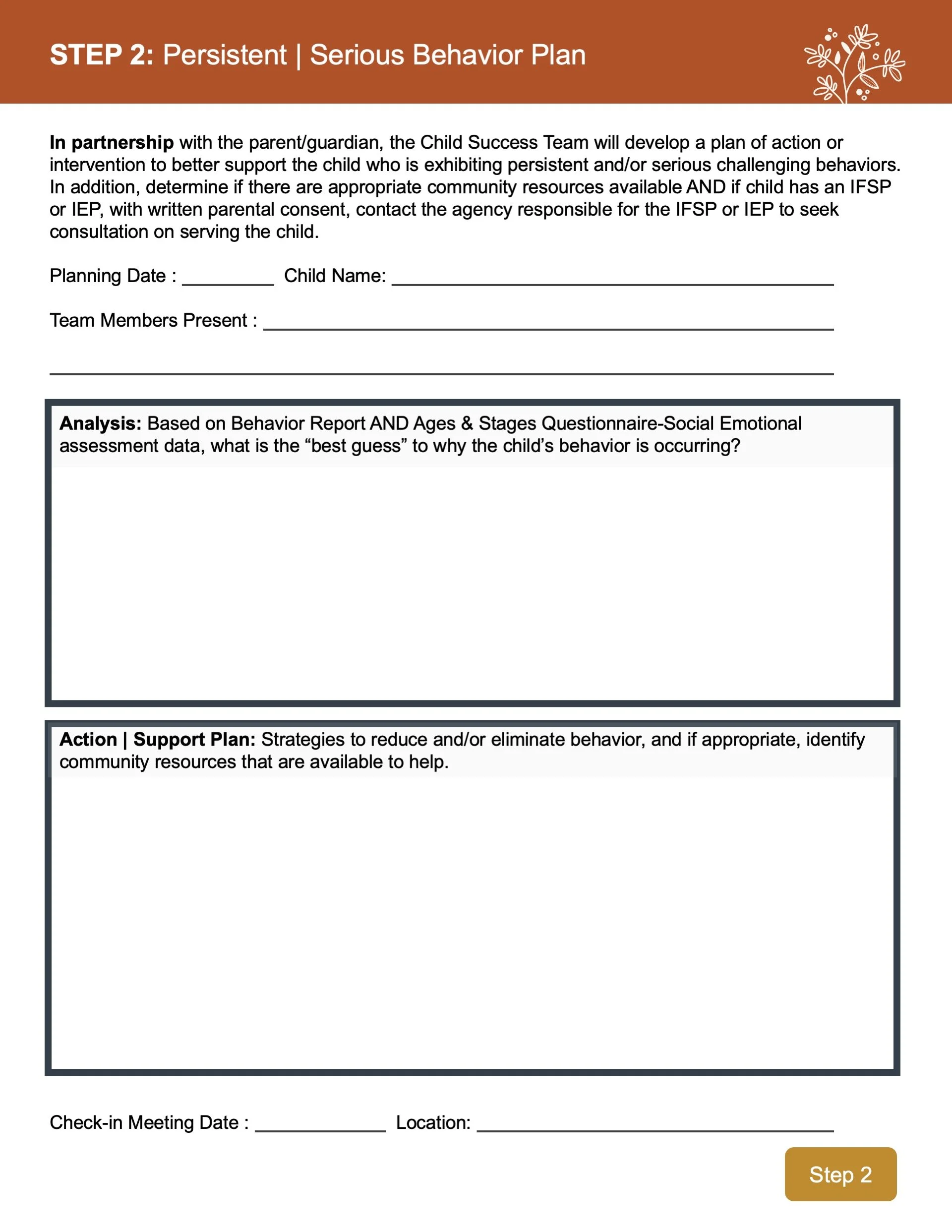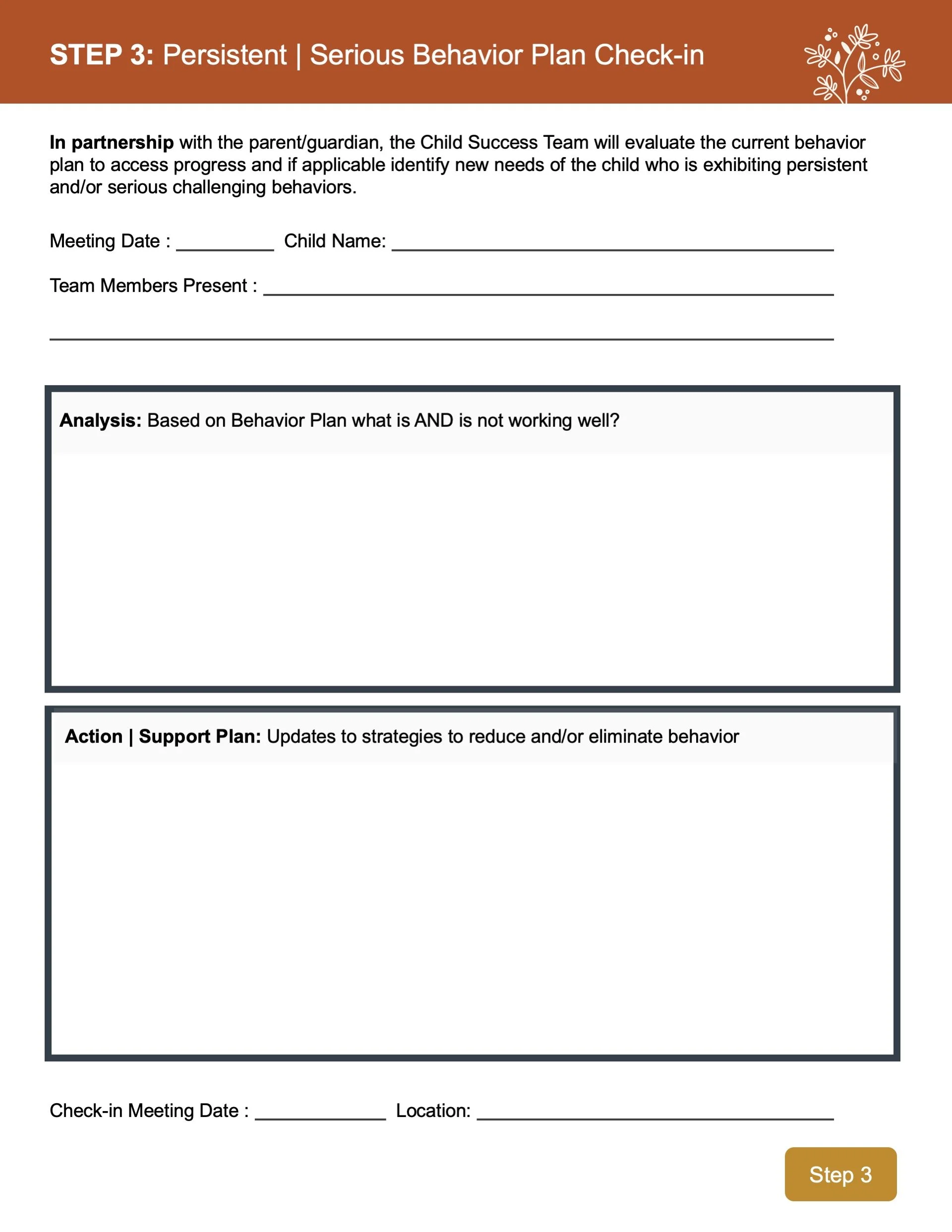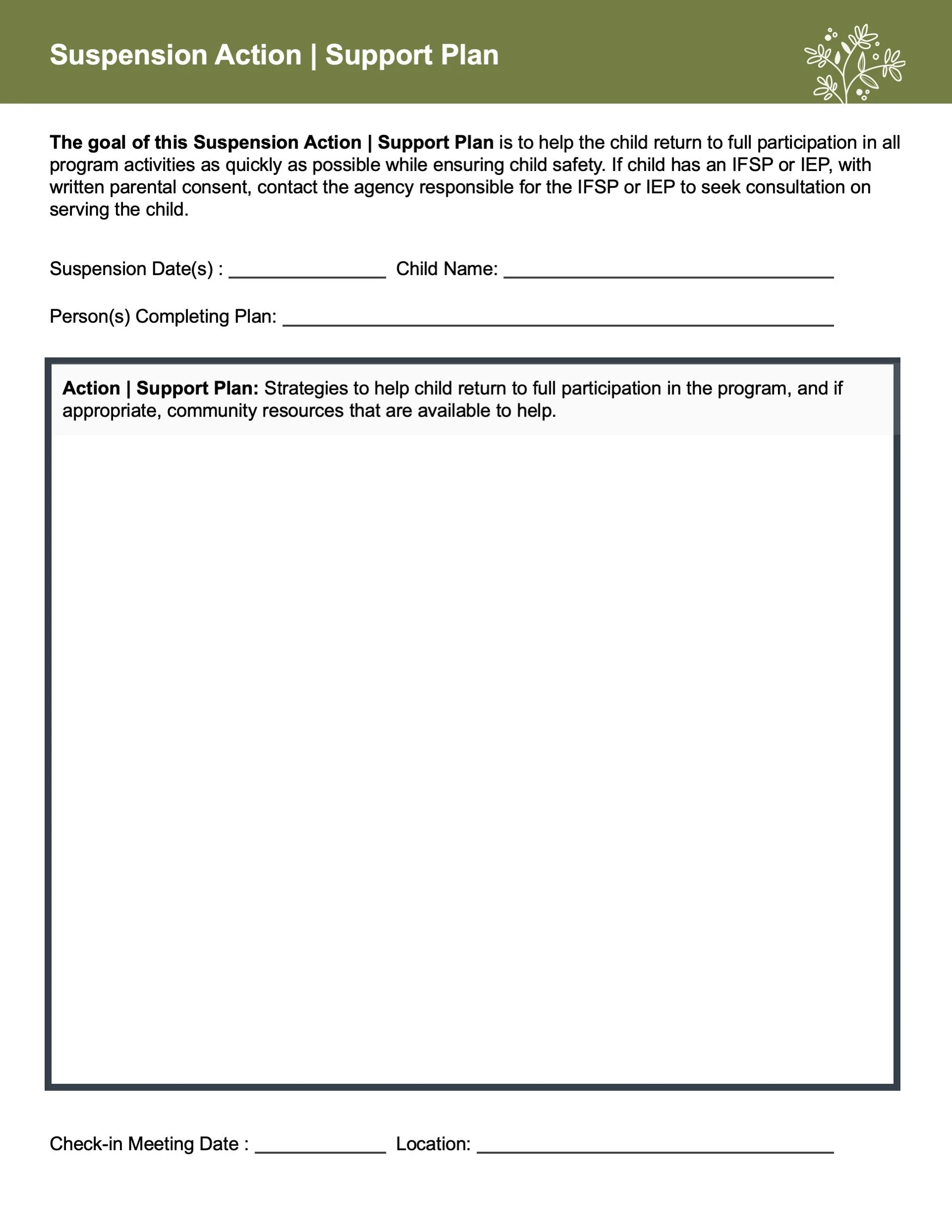Lesson 5
Health & Social Services
Lesson 6
Site Licensure & License Exempt
Lesson 7
Staff-Child Ratios
Lesson 8
Environment Rating Scale
Lesson 9
Nutritional Needs
Lesson 10
Desired Results Profile & Data
Lesson 11
Qualified Staff & Director
Lesson 12
Staff Development
Lesson 13
Refrain from Religious Instruction
Lesson 14
Inventory Records
Lesson 15
Annual Evaluation Plan
Lesson 16
Fiscal
Lesson 17
CDMIS 801A & 801B Reporting
Lesson 18
Contractor Policies
Compliance Indicator
Prior to enacting suspension or expulsion actions, the program must implement required procedures to maintain the child’s safe participation in the program (applicable to ages 0 through 5, up to the sixth birthday).
The program shall notify parents or legal guardians of persistent and serious behaviors in the program. In addition, the Contractor shall follow the process documented in WIC codes 10491 and 10491.1.
The program shall provide a description of the behaviors and the program’s plan for maintaining the child’s safe participation in the program.
The contractor shall take immediate action to issue the Notice Of Action (NOA) to the parents or legal guardians and implement the suspension or expulsion with an effective date no less than 24-hours after the service of the notice. The program must adhere to due process requirements (within 180 days) prior to expelling a child due to behavior.
Regulations/Reference
CCD Program Instrument: II. Family Engagement CCD 09
Welfare & Institutions Code: 10491 and 10491.1
Monitoring Review Evidence
List of local contacts or partners who will provide consultation, social service and/or mental health, or behavioral services for the program.
Documentation of policies and procedures outlining suspension and expulsion and as to which behaviors would warrant an expulsion. These behaviors may include, but are not limited to physical aggression, property destruction, and self-injury.
Evidence of procedures, supports, and mental health resources utilized in the event that a child needs additional supports in the classroom/home.
Review of the appeal process in written policies: In the event that at a child has been suspended or expelled the process of requesting a hearing will be directly with the State.
Watch Video Lesson ❯
Sample Forms/Tools ❯
Review Sketch Pad Notes ❯
Written Materials
Written Policies & Procedures
Written materials/policies to address persistent and serious behaviors must include:
Description or policy to include proactive and preventive guidance that reinforces appropriate behaviors.
Types of developmentally appropriate interventions used when redirecting inappropriate behaviors.
Plan to ensure the safe participation of all children in the program.
Procedure for requesting a meeting with the family if the child’s behaviors are persistent and serious. Preferably this meeting would be in person, however a virtual or phone meeting may be needed to ensure timeliness.
Written information regarding how they will access community resources, who their community partners are, and how they will ensure timely follow up.
If the child has an IFSP or IEP, the Contractor will reach out to the agency responsible for the IFSP or IEP to discuss how to best support the child. The Contractor and the parents should be involved in this consultation to the extent possible.
EXAMPLES:
A general policy for Discipline & Guidance, and Suspension or Expulsion would be found in your parent handbook.
Staff written procedures
Steps to Support Children with Persistent & Serious Challenging Behavior
The definition for persistent and serious challenging behaviors are either repeated patterns of behavior that significantly interfere with the learning of other children, or interactions with peers and adults that are not responsive to the use of developmentally appropriate guidance. Beyond interfering with children’s learning, these behaviors can be stressful for those working with the child.
Step 1
Gather Data, Establish Child Success Team & Engage with Parent/Guardian
As soon as the behavior meets the definition of “persistent and serious”, the Contractor must document the behavior. Documentation will help the team better understand what action or intervention is needed to support a child, and may later be used to support the suspension or expulsion of a child.
EXAMPLE:
Document the behavior on a persistent, serious behavior report. The report should include:
What: Behavior Description
Where & When: Activity | Time | How Often
Who & How: Others Involved | Possible Motivation
Response: Response to the Behavior
Offer the family an opportunity to observe the child in the child care setting.
Complete screening using using Ages & Stages Questionnaire-Social Emotional AND/OR access Learn the Signs. Act Early. resources.
Establish Child Success Team (Example: Parent/Guardian, Teacher, Site Supervisor, Mental Health Consultant and/or IFSP/IEP Agency Representative)
Step 2
Develop a Plan
After the behavior has been identified, a Contractor must develop a plan to ensure the safe participation of all children in the program.
EXAMPLE:
In partnership with the parent/guardian, the Child Success Team will develop a plan of action or intervention to better support the child who is exhibiting persistent and/or serious challenging behaviors, and ensure the safe participation of all children in the program.
Determine if there are appropriate community resources available. If applicable, contact/refer.
Provide copy of Behavior Plan AND this Process | Procedure to parent/guardian.
Step 3
Behavior Plan Check-in
Evaluate behavior plan to access progress and if applicable identify new needs of the child who is exhibiting persistent and/or serious challenging behaviors.
EXAMPLE:
In partnership with the parent/guardian, the Child Success Team will evaluate the current behavior plan to access progress and if applicable identify new needs of the child who is exhibiting persistent and/or serious challenging behaviors.
Child Suspension
Suspension means any removal of a child from all or part of the program day, or the prevention of a child from attending the program for one or more days, in response to the child’s behavior. Note that moving a child to an isolated or separate room is considered "removing the child from the program.”
Except in extraordinary circumstances, a contractor shall NOT suspend a child due to a child’s behavior OR encourage, persuade, or require a child’s parents or legal guardians to prematurely pick up a child due to a child’s behavior before the program day ends.
Suspension must only be used as a last resort in extraordinary circumstances when there is a serious safety threat that cannot be reduced or eliminated without removal of the child. To the greatest extent possible, a program must endeavor to ensure the full participation of enrolled children in all program activities.
EXAMPLE PROCEDURE for suspending a child:
STEP 1: Complete the Supporting Children with Persistent | Serious Challenging Behaviors Procedure that includes:
Gather Data, Establish Child Success Team & Engage with Parent/Guardian
Develop Behavior Plan
Behavior Plan Check-in
STEP 2: If determined that suspension is deemed necessary:
Issue Notice of Action that describes the change in service level.
Effective date may be no less than 24 hours after service of the notice
Since action to suspend or expel a child involves persistent and serious behaviors impacting the safety of children, the child may not attend the program during the appeal process.
Notice must inform parent(s) of their right to file an appeal directly to the State Department
Child Success Team will develop a Suspension Action | Support Plan to help child return to full participation as quickly as possible while ensuring child safety.
Determine if appropriate community resources are available. If applicable, contact/refer.
Provide copy of Suspension Action | Support Plan AND this Process | Procedure to parent/guardian
STEP 3: Suspension Action | Support Plan Check-in
Evaluate suspension plan to access progress and if applicable identify new needs. Determine if child is able to return to full participation in all program activities.
Child Expulsion
Expulsion means the permanent dismissal of a child from a program in response to a child’s behavior.
Except in extraordinary circumstances, a contractor shall NOT expel or disenroll a child because of a child’s behavior OR persuade or encourage a child’s parents or legal guardians to voluntarily unenroll from the program due to a child’s behavior.
If contractor has expeditiously pursued and documented reasonable steps to maintain the child’s safe participation in the program and determines that the child’s continued enrollment would present a serious safety threat to the child or other enrolled children, the program may expel the child and must refer the parents/guardians to other potentially appropriate placements, the local childcare resource and referral agency, or other referral service available in the local community, and, to the greatest extent possible, support direct transition to a more appropriate placement. This determination to expel the child must be made in consultation with the child’s parents/ guardians, teacher, and, if applicable, local agency responsible for implementing the IFSP or IEP.
The contractor has up to 180 days to complete the expulsion process.
EXAMPLE PROCEDURE for expelling a child:
STEP 1: Complete the Supporting Children with Persistent | Serious Challenging Behaviors AND Child Suspension Procedures that includes:
Gather Data Screening, Establish Child Success Team & Engage with Parent/Guardian
Develop Behavior Plan
Suspension Action | Support Plan
STEP 2: If determined that expulsion is deemed necessary:
Provide copy of all Behavior Plans, Suspension Action | Support Plans AND the programs Process | Procedures followed to parent/guardian
Issue Notice of Action to disenroll child.
Effective date may be no less than 24 hours after service of the notice
Since action to expel a child involves persistent and serious behaviors impacting the safety of children, the child may not attend the program during the appeal process.
Notice must inform parent(s) of their right to file an appeal directly to the State Department
Refer the parent(s)/guardian(s) to other potentially appropriate placements, the local childcare resource and referral agency, or other referral service available in the local community, AND to the greatest extent possible, support direct transition to a more appropriate placement.
Data Collection
A contractor must maintain records for child suspension/expulsion that contain all the following information:
Number of times contractors initiated the process required for suspension during a program year, and the outcome of each reported instance, including, if applicable, how long a child was excluded from the program.
Number of times contractors initiated the process required for expulsion during a program year, and the outcome of each reported instance.
The data collected for a suspended or expelled child must include at a minimum:
Age
Sex
Race and ethnicity
Foster status
Home language
Disability, if applicable, and whether the child has an IFSP or an IEP
Complete Knowledge Check ❯
After reviewing the video lesson & sketch pad notes, it’s time to check for understanding by completing a Knowledge Check. Note that Individual Knowledge Checks will conclude with a Certificate.




